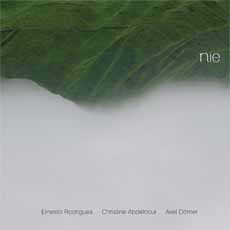
Ernesto Rodrigues
Christine Abdelnour
Axel Dörner
cs203
One of the most abiding memories from my childhood is of a drawer at my grandmother?s
house full of a mass of tangled bits of cotton thread, wool and string that she kept for some
reason, like grandmothers do. I didn?t visit her often, but when I did I would be fascinated
by the tangle of different colours, textures and thickness and would enjoy picking out the
end of one thread, pulling it gently to see how far it would unravel before it took a hold in
the enmeshed bundle. Some threads would jump out at me, brightly coloured, just asking
to be tugged at, others would seem to be there just to hold the bolder colours in place. I
always wondered how all of these pieces of thread came to be like this. This entwined
mass seemed to be their natural state, but I wanted to separate it all out, understand how
it all locked together.
Today I have similar thoughts about improvised music, of which this CD is a fine example.
Listening at a slight remove, the music is a mass of meshed colours and textures, some
bright and bold, some aggressive, out to grab our attention, and others seemingly there
just to hold it all together, to stop the fragile structure from falling apart. In good improvised
music every sound has a purpose, nothing is thrown away, and within the music on this
album each sound is where it is because a skilled musician placed it there. However the
music cannot be without an element of chance. A brightly coloured thread placed by one
musician cannot know that it will not suddenly meet a deep, thick black twine laid down by
another or a mass of thin sinews from a third. The sounds on this beautiful album wrap
together in the moment. As no architect could plan the course of each thread in a bundle of
wool, no composer could notate music this alive. The only question remaining for the
listener is whether to view the music as a whole or try and tug at the individual threads to
see how much unravels.
Richard Pinnell